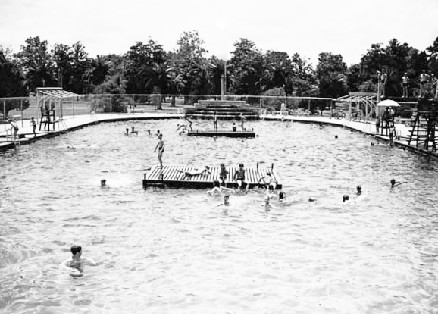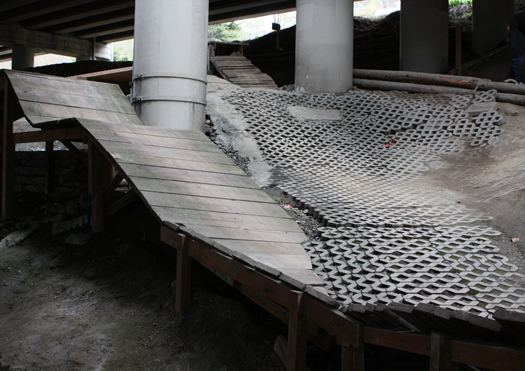 |
| bleached out at City Park |
There used to be a pool at City Park as well, but it was closed under segregationist mayor Victor H Schiro in the 1960's to avoid integration (along with public pools at Audubon Park and Ponchartrain Beach). This caused several generations of New Orleanians to not know how to swim - compounded by pollution in Lake Ponchartrain, which was not considered passable for swimming until 2006.
While the regular posting of Ponchartrain's fecal count in the Times Picayune has disappeared, the closest 2 legal beach access points are on the North Shore... 30+ miles from New Orleans. South-shore beach access exists behind the FBI buildings at UNO, at Lincoln Beach in the East, and elsewhere, but swimmers are at risk of police harrassment if they try to take a dip... I've learned this the hard way. I remember last summer, when 2 kids drowned in Ponchartrain and the whole Orleans Parish lakefront was fenced off... is liability the main reason for no Ponchartrain swimming? Really???
 |
| Lincoln Beach, the "colored beach", became rundown and abandoned after integration led business interest elsewhere. The movie "Sunshine State" and the book "The Land Was Ours" both tackle the idea of real estate disinvestment + future white encroachment upon historically African-American spaces post-integration. |
This year the City of NO cut the budgets for public pools, meaning that the swimming season is shortened to no longer include August... June + July only. New Orleans Recreation Department Commission (NORDC) Director Vic Richard has opened 7 new pools around town since his arrival in 2010, but says "if New Orleans wants its citizens to know how to swim the city may need to create a dedicated revenue stream to pay for them — or charge more to use the pools." Paying for public park entry... a scary thought.
On the bike ride to the Stallings Gentilly Pool today, I passed the empty corner lot where the corner store across from the park used to stand, now demolished after damage from Hurricane Isaac in 2012. While waiting for lunch break at the pool to end, I wound up talking to a woman with the local neighborhood organization, petitioning for the corner store to be disallowed from selling alcohol upon reopening. Before, it had been grandfathered-in for selling alcohol next to a public park, and neighborhood residents were hoping now was their chance to create a less alcohol-centered environment at Stallings Gentilly Park. It seemed a funny coincidence that I was having this conversation only minutes after being suprised that there were kids sitting all around the park's picnic tables, as opposed to the usual older men drinking and watching the shade pass. While everyone is more than entitled to public space, alcohol is available at arm's reach across this town while public spaces that children can enjoy safely are dwindling and becoming more and more regulated + pre-determined. If taking out liquor sales on one corner can deterritiorialize some picnic tables from the drinkers and provide unprogrammed space for youth below some live oaks, I'm behind it. Big important questions remaining with "public interest" and "improving space" ask WHY we desire to change these spaces, and HOW it is done: "Why do I object to the situations I desire to change? Is it an objection to actions or to the individuals involved in the actions? How does this reflect my own personal experiences and leanings? Once the situation is changed, what happens to former users? Where do they go, and how does this work for them and your own views?" Examine biases, take on other points of view and throw out NIMBYisms, avoid categorization and oversimiplification.
The same neighborhood group had held a recent "public input meeting" discussing Stallings Gentilly Park renovations + repairs. "Capital projects": where the city decides to go through with a large-scale build (such as $300,000+ repairs and improvements for a park), and must raise huge amounts of funding for its completion. This is rooted in the means through which municipalities contract work done through bidding, "without bias". By putting money as the bottom line and dehumanizing the development process, the fear of personal biases is removed. This space is then often filled by prioritizing profits over people... instead of focusing on socially-responsible components such as hiring local + disadvantaged workers, user-determined + maintained space, inclusive design, environmentally responsible processes, local methods of production, etc.
The term "capital projects" itself reveals the mindset of this type of development, an assumption that large-scale public works cannot exist apart from large-scale funding. This logic comes into question when the City of New Orleans cuts funding for running public parks but can still justify $100k for a fence repair. I heard the other day that it costs the city $10,000 to install a water fountain. Seems in line with "We cant allow you to continue construction of this skatepark because of financial liability", while kids having few positive outlets for their energy is at the same time leading to much-worse liabilities of crime and murders. Priorities? People v Profits (or, fear of losing moneys) 2013.
 |
| user-built + managed bike trails at Colonnade Park under I-5 in Seattle. Read about this case study with reflection on capital projects vs user-dependent projects at Mammoth blog. |
SO now we zoom out from New Orleans, keeping the topic of businesses shaping the development and use of public space, bringing us to the recent unrest in Istanbul over development plans for Gezi Park/Taksim Square. In short, the sycamore groves of Gezi Park are to be demolished so that a historic barracks can be rebuilt, while creating an underground tunnel for automobile traffic. This would open the area for a pedestrian plaza interspersed with unnatural planting areas and surrounded by shopping opportunities. Peaceful protests over the removal of free public space met with police repression, escalating to international news highlighted Istanbul's public spaces being decimated by rampant development, with 2 million square meters of mall space already under construction.
 |
| existing layout of Gezi Park/Taksim Square, Istanbul |
 |
| proposed layout of Taksim Square, Istanbul. Reworking of traffic patterns for pedestrian zones reminds me of New Orleans' Livable Claiborne studies + proposals. images via BBC. |
While technically free to enter, the surrounding shopping center pushes the expectation that users of the plaza will also be spending money, in effect privatizing a public space. In the United States, this expectation has become a normal development process: public pedestrian plazas are often subsidized by business interests that benefit from the foot-traffic, creating public plazas that are part park, part mall. The "park" idea is broken by having more built space than natural space and less infrastructure for those unwilling/unable to spend money on relaxation, while the "mall" is slightly shifted into independently operated stores that lie along the same path instead of under a shared roof.
This partial-privatization process' beginnings lie within developers recognizing the shortcomings of allocating large sums of money for capital projects via City Councils and other regulating bodies from public budgets... many of the components of project development are best left to entities closer to the ground level, though by removing development from the realm of public scrutiny, there is less reason for larger varying swaths of people to be beneficiaries of the development and more chances for invested individuals' personal gain. Monetary value is our society's usual expression of worth and is associated with individual success instead of the strength of a community or network. What if space was valued by use instead? This puts emphasis on inclusiveness, agency, responsibility, stewardship, opportunities to grow, and other characteristics that everyone can benefit from regardless of class or caste.
The compromising of public green space in favor of capital is happening all around us daily, creating more manufactured natural environments and controlled-access built environments: the expansion of prison mentality into our daily lives.
 |
| Incarceration necessitates replication of natural surroundings. James Bowlin, United States Penitentiary, Marion, Illinois; photograph courtesy Alyse Emdur. Note the fake trout. See Alyse's Prison Landscapes interview at BLDGBLOG. |
more:
*NY Times: Unearthing a Town Pool, and Not for Whites Only
*Andrew Kahrl: Warning: Black People at Leisure: "Indeed, the historical forces that led to the tragic death of [Trayvon] Martin and those that have steadily re-segregated and privatized America’s leisure spaces are deeply entwined."
*Green Prophet: Istanbul's Taksim Square to Become Lifeless and Isolated in New Urban Plan, Opponents Warn
*ArchDaily: When Urban Planning Gets Political - The History of Taksim Square
*Play-Scapes: Battle for the Builder: The Norrebro Playground Riot, Copenhagen, 1980: Amidst protest, a community's adventure playground is demolished and immediately rebuilt from an adjacent construction site. Demolition begins again as constitution is suspended to allow police violence against protesters. See video at the bottom of page with an awesome soundtrack.
